US wind install tumbles 25% hit by supply chain woes and surging inflation: ACP report
Plant totalling 12.7GW built last year is the third biggest deployment in sector history but comes in below expectations after record 2020, says industry body

The US installed 12.7GW of wind capacity in 2021, the third largest year on record but considerably below expectations as supply chain constraints and surging inflation negatively impacted the economics and timelines of various projects, according to the latest market analysis from the American Clean Power Association (ACP).
ACP reported that sponsors in the quarter moved back commissioning of 5.5GW of wind projects, most to this year, but more than 800MW to 2023-2024.
The industry began 2021 looking to match or exceed the previous year’s best-ever installation performance largely in anticipation that then-incoming President Joe Biden would work closely with Congress led by his party to formulate long-term federal policy support for clean energy.
“We urge Congress to take action to create a clean energy future that will help create more good paying American jobs and combat the climate crisis,” said ACP CEO Heather Zichal.
Biden had also pledged he would marshal he full resources of the federal government to “shut down” the Covid-19 virus by July, raising industry hopes that he would do a better job than his predecessor to control the pandemic.
Instead, a record number of workers fell sick from the successive delta and omicron variants, causing absenteeism to surge on factory floors and throughout the supply chain. Logistical bottlenecks and materials shortages also worsened as some port workers and truckers refused to comply with Biden’s vaccination mandates which ultimately were overturned in the courts.
Onshore wind heads for 'marked' slow-down
Another unwelcome development was inflation now at its highest level in four decades that is hurting profitability throughout the wind value chain. Recent data suggests that inflation – producers prices in January increased 9.7% on a 12-month basis – has not peaked, adding uncertainty for project developers.
These factors will contribute to a marked slowdown in 2022 activity with both BloombergNEF and IHS Markit expecting about 9GW in new capacity.
Even if much of the fourth quarter capacity does come online this year, onshore wind’s share of the total US 120.2GW clean energy project pipeline (20%) continues to decline with battery storage (10%), offshore wind (15%), and utility solar (55%) all gaining market share.
This partly reflects federal and state policies that favour those technologies. Not having the PTC deprives the sector with necessary longer-term visibility to ramp new investments, particularly in areas of the country such as the northeast where lower wind resource makes projects less cost competitive.
In contrast, offshore wind and solar continue to benefit from the federal investment tax credit (ITC), which helps sponsors better compete for long-term off-take deals. Utility solar accounted for 70% of the record 28.1GW in new clean energy PPAs announced in 2021 versus 18% for wind and 11% for battery storage.
“Solar and storage PPA announcements increased by 33% and 95%, respectively, since 2020. Wind PPA announcements decreased 17% from 2020,” ACP said in the report. Analysts expect corporate offshore wind procurement to ramp as the sector gains scale in the next several years.
Onshore wind is also more challenged by grid connectivity issues that include high upgrade costs to tie projects into the existing network or to build new heavy-duty, long distance transmission from remote resource rich areas to major population centres.
(Copyright)